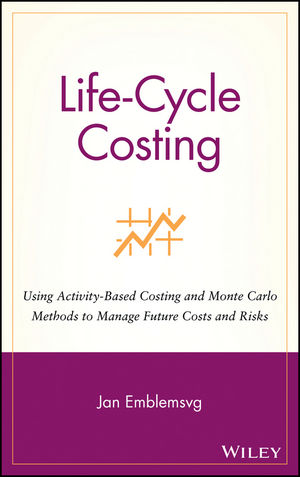Life-Cycle Costing: Using Activity-Based Costing and Monte Carlo Methods to Manage Future Costs and RisksISBN: 978-0-471-35885-5
Hardcover
336 pages
March 2003
 This is a Print-on-Demand title. It will be printed specifically to fill your order. Please allow an additional 10-15 days delivery time. The book is not returnable.
|
||||||
Acknowledgments.
1. Introduction.
What Does It Cost?
The Role of Life-Cycle Costing.
Why Activity-Based Life-Cycle Costing?
Notes.
2. Basics of Life-Cycle Costing.
What Is a Life Cycle?
What Is a Cost?
Four Ways of LCC.
Notes.
3. Uncertainty Analysis and Risk Management.
What are Risk and Uncertainty?
Uncertainty, Risk, and Utility.
Common Ways of Analyzing Risk and Uncertainty.
How Belief Sheds Light on Risk and Uncertainty.
Reduce Risk by Introducing Uncertainty: How Monte Carlo Methods Work.
Traditional Risk Management.
Notes.
4. Activity-Based Costing.
Motivating Example.
Activity-Based Costing.
ABC Example and Case Study.
From the Trenches.
Notes.
5. Activity-Based Life-Cycle Costing.
Step 1: Define the Scope of the Model and the Corresponding Cost Objects.
Step 2: Obtain and Clean Bill of Materials for All Cost Objects.
Step 3: Identify and Quantify the Resources.
Step 4: Create an Activity Hierarchy and Network.
Step 5: Identify and Quantify Resource Drivers, Activity Drivers, and Their Intensities.
Step 6: Identify the Relationships between Activity Drivers and Design Changes.
Step 7: Model the Uncertainty.
Step 8: Estimate the Bill of Activities.
Step 9: Estimate the Cost of Cost Objects and Their Performance Measures.
Step 10: Perform Monte Carlo Simulations and Relevant Analyses.
Further Explanation Regarding Some Steps.
Notes.
6. Case Study: Life-Cycle Costing and Tire Disposal.
What the Decision Is About.
Traditional LCC Implementation.
Activity-Based LCC Implementation.
Discussion.
Closure.
Epilogue.
Notes.
7. Activity-Based Life-Cycle Costing for Platform Supply Vessels.
Operating a Platform Supply Vessel.
Problem Statement and System Boundaries.
Information Sources.
Activity-Based LCC Model Implementation and Results.
Identifying the Major Operational Risks.
Closure.
Notes.
8. Activity-Based Life-Cycle Costing at WagonHo!
WagonHo!’s New Strategy and Business Idea.
Developing an Activity-Based LCC Model.
Results and How to Use Them.
Closure.
Notes.
9. From Hindsight to Foresight.
Activity-Based LCC Revisited.
Ideas for the Future.
Some Thoughts at the End.
Notes.
Appendix A Monte Carlo Simulation Example.
Problem Definition.
Hypotheses to Be Tested.
Results and Discussion.
Appendix B SFI Group System.
Glossary.
Acronyms.
Index.



